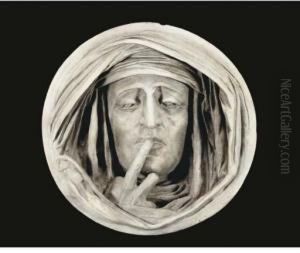Auguste Preault Paintings
Auguste Préault was a French sculptor known for his romantic and expressive style, which significantly diverged from the neoclassical norms prevalent during his time. He was born on October 11, 1809, in Paris, France. Préault began his artistic education at the Petit École before moving on to study under renowned sculptor David d'Angers. Despite his training, Préault's unorthodox approach often put him at odds with the official art establishment, and his work was regularly rejected by the conservative jury of the Paris Salon, the official art exhibition of the Académie des Beaux-Arts in Paris.
In the 1830s, Préault gained some recognition for his sculptural relief 'Tuerie' (Slaughter), which was part of a decorative project for the Arc de Triomphe in Paris. However, it was his relief titled 'Ophelia' (1833), inspired by the character from Shakespeare's 'Hamlet,' that cemented his reputation as a romantic artist. The work was rejected by the Salon but was celebrated in the literary circles of the time for its emotional depth and innovative style.
Préault's work was characterized by its dynamic forms, dramatic expressions, and often somber themes. While he was influenced by the romantic movement, he also foreshadowed the symbolist and expressionist movements that would emerge later. Despite his struggles with the artistic authorities, Préault received commissions for various public monuments and funeral sculptures, which are some of his most enduring works. His sculptures can be found in many cemeteries around Paris, including Père Lachaise.
During the 1848 Revolution in France, Préault was actively involved in the political upheaval, aligning with the socialist and republican causes. This political engagement may have further affected his standing within the conservative art circles of the time.
Auguste Préault continued to create art that pushed the boundaries of the establishment until his death on January 6, 1879, in Paris. His legacy is marked by a body of work that reflects a passionate and emotive response to the human condition and a willingness to defy the artistic norms of his era. Today, his sculptures are recognized for their innovative qualities and are studied for their contribution to the evolution of modern sculpture.
